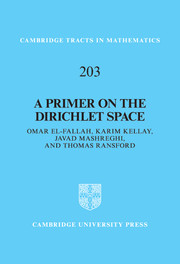Book contents
- Frontmatter
- Dedication
- Contents
- Preface
- 1 Basic notions
- 2 Capacity
- 3 Boundary behavior
- 4 Zero sets
- 5 Multipliers
- 6 Conformal invariance
- 7 Harmonically weighted Dirichlet spaces
- 8 Invariant subspaces
- 9 Cyclicity
- Appendix A Hardy spaces
- Appendix B The Hardy–Littlewood maximal function
- Appendix C Positive definite matrices
- Appendix D Regularization and the rising-sun lemma
- References
- Index of notation
- Index
Appendix D - Regularization and the rising-sun lemma
Published online by Cambridge University Press: 05 January 2014
- Frontmatter
- Dedication
- Contents
- Preface
- 1 Basic notions
- 2 Capacity
- 3 Boundary behavior
- 4 Zero sets
- 5 Multipliers
- 6 Conformal invariance
- 7 Harmonically weighted Dirichlet spaces
- 8 Invariant subspaces
- 9 Cyclicity
- Appendix A Hardy spaces
- Appendix B The Hardy–Littlewood maximal function
- Appendix C Positive definite matrices
- Appendix D Regularization and the rising-sun lemma
- References
- Index of notation
- Index
Summary
In this appendix we prove a regularization lemma, Lemma 9.4.5, used in establishing Theorem 9.4.1. The principal tool is the notion of the increasing regularization of a function, and we begin by examining this separately.
Increasing regularization
Definition D.1.1 Given a function u :[0, ∞) → [0, ∞), we define its increasing regularization ũ: [0, ∞) → [0, ∞)by
Clearly ũ is increasing and ũ ≤ u. Also, ũ is maximal with these two properties, in the sense that, if ν is any increasing function with ν ≤ u, then also ν ≤ ũ.
We shall need two results about increasing regularizations. The first is a version of the so-called rising-sun lemma of F. Riesz.
Lemma D.1.2Let u: [0, ∞) → [0, ∞) be a function that is lower semicontinuous and right-continuous. Let ũ be the increasing regularization of u and define U:= {x ∈ [0, ∞): ũ(x) < u(x)}. Then U is open in [0, ∞). Further, if a, b are the endpoints of any component of U, then u(a) ≥ u(b).
Proof Let x ∈ U. Then there exists y > x such that u(y) < u(x). By lower semicontinuity u(y) < u(x′) for all x′ in a neighborhood of x. All such x′ also belong to U. Thus U is open in [0, ∞).
Now let a, b be the endpoints of a component of U.
- Type
- Chapter
- Information
- A Primer on the Dirichlet Space , pp. 193 - 196Publisher: Cambridge University PressPrint publication year: 2014

